Di Sotto In Su
by Dr. Luis M. Gómez Wulschner
Introduction
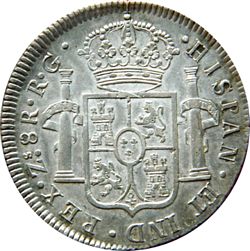
Crown with a double arc, di sotto in su, on a Zs 1821 RG coin
The present work has to do with a curious detail which appears at the base of the Bourbon crown stamped into the Spanish coat-of-arms of a few coins of the 1821 RG Zacatecas mint. The detail I am referring to is the double arc, also known as the secondary or inferior arcFrank F. Gilboy, The milled columnarios of Central and South America. Spanish American Pillar Coinage, 1732 to 1772, 1999,Prairie Wind Publishing, USA. p. 61, which may be seen directly below the small basket of the crown, which is named “di sotto in su” and is translated from Italian “from below, upwards”, and which in the decorative arts of the XVII and XVIII centuries in Italy was used to paint roofs in perspective. That is, the fact that the double arc exists at the base of the crown lends itself to the optical illusion of seeing it in perspective. Practically all the coins struck in Spain as well as in New Spain do not show this characteristic, except for a few examples. Such are those coins of Philip V minted at Segovia and Valencia and those pillar type half-reales struck at the Mexico City Mint from 1732 to 1771.
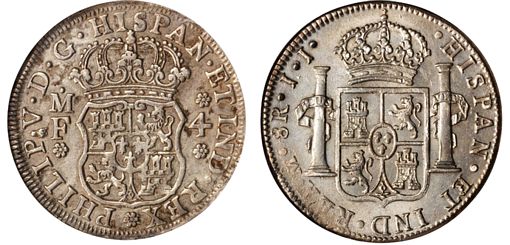
Reverse of a 4 Real Pillar Dollar (Philip V) and an 8 Real bust coin (Ferdinand VII) struck at the Mexico City Mint.
Both without the double arc
Nonetheless, another case took place in New Spain at the Royalist Mints of Guadalajara and Zacatecas. Of the former, not all the dates bear this characteristic on the crown, but only the silver coins dated 1818, 1821 and 1822 FS and the 1821 gold coins. The following figure shows the reverse of an 1814 and 1821 eight real coin and an 1821 eight escudo piece struck at the Guadalajara mint bearing both types of crowns.

Normal crown (1814) and double arc crowns, di sotto in su, on silver and gold (1821) Guadalajara mint.
Reverses of an 8 Real and 8 Escudos
The logical question is: why did this characteristic appear on coins struck at the Guadalajara mint in 1818, and later, on a few assayer RG Zacatecas pieces? The hypothesis I have, and which I will try to explain in this brief work, has to do with the presence and work of a very interesting personage, Dionisio Sancho, who was a draftsman, engraver and chamber sculptor, appointed by his Majesty Charles IV in 1795 (Rafael Fernandez-Sotelo and Mariana Mantilla Trolle, La Nueva Galicia en el ocaso del Imperio Español: los papeles de derecho de la audiencia de la nueva Galicia del licenciado Juan José Ruiz Moscoso su agente fiscal y regidor del Ayuntamiento de Guadalajara, 1780-1810, Volumen 1, Universidad de Guadalajara. Mexico., 2003, p.77).
Provisional Mints
Practically since the Royal Mexico City Mint began to operate, the master dies used to create the punches were sent from Spain. When the war for Independence began in 1810, the routes and tracks used for silver transportation were seriously threatened and therefore it became necessary to open several provisional mintsPilar González Gutiérrez, Creacion de casas de moneda en Nueva España, Universidad de Alcala, Spain, 1997, p. 225. Thus, the hegemonic Mexico City Mint gave way to the establishing of provisional mints at the principal mining centers in New Spain: Chihuahua, Durango, Guanajuato, Sombrerete and Zacatecas in 1810; Guadalajara and Real de Catorce in 1811; Oaxaca in 1812 and Valladolid in 1813. The last three did not prosper and produced very limited mintages. During the first years of operation of these provisional mints, the engravers cut dies in a very rudimentary fashion. Later on, the master dies would be sent from the Mexico City Mint.
The Guadalajara Mint
Field Marshal José de la Cruz, who at that time was provincial governor, military commander and president of the Guadalajara tribunal court, on 20 May 1911, convoked the advisory board of the Royal Treasury to found and establish a provincial mint in that city. It was located at the lower part of the parliament building and José María Zavala was named director and Manuel Rivera, assayerMartha Gabriela Sánchez Anaya, Las vicisitudes monetarias de los tapatios. La ceca de Guadalajara 1811-1895. Secretaría de Cultura, Jalisco, Mexico, 2003, p. 53.
Toward the end of 1813 the new director was Juan José Jiménez Sandoval. Due to distrust generated between the Royal Treasurer and the assayer, among other vicissitudes, such as the circulation in the region of counterfeit coins from Durango, Guanajuato and Zacatecas as well as insurgent counter-stamped coins, the Guadalajara Mint was closed by order of the viceroy on 30 March 1815José Toribio Medina, Las monedas obsidionales hispano-americanas, Imprenta Elzeviriana, Chile, 1909, p. 64. Nevertheless, this disposition was not applied until 30 April González, op. cit. p. 239; A. F. Pradeau, Historia Numismática de México. Desde la epoca Precortesiana hasta 1823, 1950, Banco de México, Mexico, p. 148. The assayer, Rivera, was removed from his post and imprisoned for his shady dealings and the director, Jiménez, resigned one month after the mint was closedSánchez, op. cit. p. 59.
On 6 April 1816, Viceroy Félix María Calleja appointed the architect, engraver and professor of sculpture at the Royal Academy of San Carlos, Dionisio Sancho, director of the Guadalajara mint.
The reconstruction of new minting machinery and remodeling of the building were undertaken immediately, and what is perhaps the most important for us was the cutting of new dies and punches taken from the master dies obtained from the Royal Mexico City Mint. All these works were concluded by December that same yearSánchez, op. cit. p. 60.
What was the reason for the arrival of Dionisio Sancho in New Spain? Due to Napoleon’s invasion in 1808 and the ascension to the throne of José Bonaparte, the situation became difficult for Sancho: therefore he moved from Seville to Madrid where by royal order of 20 August 1810 he was appointed Director of Sculpture at the Royal Academy of San Carlos. Thus, with this appointment and a recommendation addressed to the secretary of the academy, Don Antonio Piñeiro, he migrated to New Spain on 16 February 1811. At the meeting of the Superior Governing Board (Junta Superior de Gobierno) the appointment granted by his Majesty was read, but, since that position had already been taken by the eminent Manuel Tolsa, the board decided to transfer him to the position of Director of architecture, which had been vacated when Francisco Clapera died. When his advanced attributes and knowledge of the noble arts became evident, as well as his experience engraving punches and dies, Viceroy Calleja did not hesitate to send him to Guadalajara to organize and reopen that mint; he assigned him an annual salary of 2,000 pesos (González, op. cit, p 239). However, due to the incompetence of the deputy assayer, the mint did not operate again until February 1818, when Francisco Suárez, also appointed by Félix María Calleja, became the new assayer.
As mentioned before, the master die, from which the engraver produced the punches to cut and complete the die, was sent by the Royal Mexico City Mint to the provisional mints.
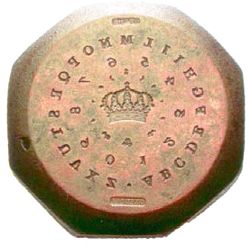 Master die with a crown, numbers and letters
Master die with a crown, numbers and letters
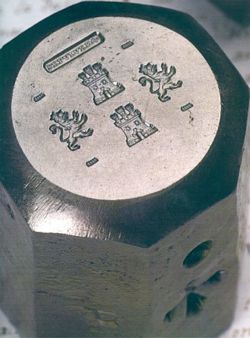
Master die with towers and lions to form the Spanish coat-of-arms
Once installed in Guadalajara, Dionisio Sancho engraved the punches and dies to produce the brilliant eight Reales coins that were to see the light dated 1818.
If one compares these pieces with the previous 1815 issues, the outstanding quality which Sancho achieved on these coins with the new machinery and dies is clearly discernible; to such an extent that the chief engraver of the Realm and the Royal assayer had a coin tested from each provisional mint. The result indicated that both in regard to its fineness of silver and the high-quality of its production, no defect could be found in the coin struck at the Guadalajara mintGonzález, op. cit, p. 241.
 Guadalajara 8 Reales, 1822 FS. Crown with the double the arc, di sotto in su. Obverse and reverse
Guadalajara 8 Reales, 1822 FS. Crown with the double the arc, di sotto in su. Obverse and reverse
For some unknown reason, our personage, Dionisio Sancho, engraved the double arc “di sotto in su” on the chief punch or master die, a step previous to the production of the final dies, a characteristic which may be seen on practically all the gold and silver coins struck at the Guadalajara mint during 1818, 1821 and 1822. Why he engraved the lower part of the crown on the chief punch will always be a mystery; nonetheless, it caused the reproduction of this detail on all the dies used for different mintages, and, since this peculiarity appears on the reverse of the coins, it forms part of the design of all the dies, time and again, regardless of the date of issue. Having said this, it is also inferred as such, with the presence of this detail on some Zacatecas 1821 RG coins precisely upon his arrival at the Zacatecas mint.
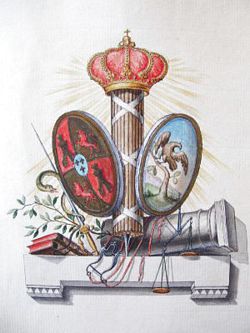
Coat-of-arms painted by Sancho in the Sala de Audiencias at Guadalajara
Despite the success obtained as director of the Guadalajara mint, Dionisio Sancho was obliged to leave the city toward the end of 1820 because of a long, painful legal case that had lasted three years, which had been initiated by the public prosecutor of the Royal Court of Guadalajara, Vicente Alonso Andrade, and Manuel Mendiola, the prosecutor of this crime. According to prosecutor Alonso, in the recent decoration of the court hall, a work entrusted to Dionisio Sancho while he was in charge of the mint, the artist had painted subversive elements next to the Spanish coat-of-arms, such as an example of an “Insurgent eagle” , similar to that which appeared on coins issued by the American Congress (Fernandez and Mantilla, op. cit. pp. 78-80).
Dionisio Sancho in Zacatecas
During the last months of 1820 Manuel Ramos was still the chief director of the Zacatecas mint, and the coinage until then had been known for its lack of quality, practically since its beginning. In order to remedy this problem the viceroy consulted Dionisio Sancho who had perfected coinage production at the Guadalajara mint; he asked him for his opinion regarding the possibility of reforming the Zacatecas coinage. Sancho considered the coinage to be deplorable, even suggesting it to be an offense to his majesty. He answered that it would be possible to do it without requiring extensive financial investment and he, himself, would commit to undertake the task Juan Fernando Matamala, “La Casa de Moneda de Zacatecas (1810-1842)”, in La moneda en Mexico, 1750-1920, UNAM, Mexico, p. 178. Dionisio Sancho was appointed by the Viceroy to be Director of the Zacatecas Mint and was confirmed by royal order on the first of January 1821.
It is probable that Sancho arrived at the Zacatecas mint with the necessary set of tools in order to carry out his work effectively. Perhaps, among his tools there was a punch or die with the double arc crown or in perspective “di sotto in su”. Thus, the conclusion is that, only a few coins, always cataloged as rare and even as errors (Levy, 2002:73), dated 1821 and with assayer letters RG (José Rodríguez Gallinar) bear the characteristic of the double arc at the base of the crown.
“Di sotto in su” on the 1821 RG coins of Zacatecas
During the year 1821 the Zacatecas mint produced ½, 1, 2 and 8 Reales coins. There were three assayers: AG, RG and AZ on the one and two Reales, while there were two assayers, AG and RG, and RG and AZ on the one-half and eight Reales respectively. It is worth mentioning that the production was considerably high that year, with over 2.4 million pesos mintedPradeau, op. cit, p. 155. Perhaps this is why there were three assayers, a unique situation among the provisional mints during the war for Independence.
It is strange that only a handful of coins with values of one, two and eight Reales bear the described characteristic at the base of the crown on the shield of Spain.
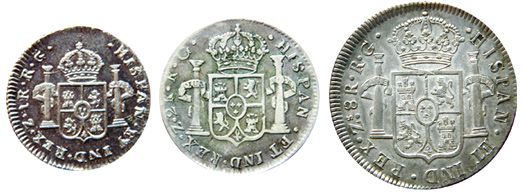
One, two and eight Reales 1821 RG Zacatecas coins. Double arc crowns, di sotto in su, reverses
At this time I have been unable to find an example of a half Real with this peculiarity; also, specialized books only catalog the eight Reales (KM-111.6) lacking the indication of this variety on one and two Reales coinsDavid C. Harper, North American Coins and Prices, 2002, Krause Publications, USA. p. 480.
Since the double arc exists only on a few coins of Zacatecas, as we have indicated, no doubt this peculiarity was on the working die, while in the case of Guadalajara it obviously was on the chief punch and thus it was reproduced on the dies and, therefore, on all the coins of that mint during the specified years.
In a visual inspection of 1821 RG 1, 2 and 8 Reales coins of Zacatecas we can confirm the obvious difference of the “normal” crowns and those with ““di sotto in su”.

Normal crowns of 1, 2 and 8 Reales 1821 RG Zacatecas coins

Double arc crowns, di sotto in su, on 1, 2 and 8 Reales 1821 RG Zacatecas coins
It is not known why this variety did not continue on the coinage of Zacatecas while it continued until 1822 at the Guadalajara mint, despite the fact that Sancho had left that mint since the last part of 1820. I dare say the high mintage had much to do with it. That is, while the Guadalajara mint struck a little more than 255,174 pesos in 1821, during the same period the Zacatecas mint struck 2.4 million pesosManuel Orozco y Berra, Moneda en México, 1993, Banco de México, Mexico. pp. 109 and 111. Probably, once the dies with the perspective “di sotto in su” crown had worn out, they were replaced with the chief punches that the mint possessed bearing the ordinary based crown.
Besides the reason for this peculiarity, nowadays this coin is very rare and when one appears on the numismatic market, it can bring as much as ten times the amount a piece without this characteristic would bring. However, it is quite clear that when Dionisio Sancho took his leadership of the Zacatecas mint, he soon demonstrated his efficiency in producing the high quality coinage that the Sovereign Provisional Government Board (Soberana Junta Provisional Gubernativa) had demanded by decree of 19 February 1822 indicating that the coinage of Zacatecas should be received at its full face value throughout the entire Mexican Empire as if it had been issued by the Royal Mexico City MintOrozco y Berra, op. cit., p. 63.
During the six years that Sancho was in charge of the Zacatecas mint, he achieved important technological advances: he introduced three smelting furnaces, one laminating machine valued at 18 thousand pesos (his project) and a total of three screw presses. In regard to the administrative aspect, in October 1826, he drew up the bylaws of the Zacatecas mint, which were approved and decreed the following year by the Free and Federate State of Zacatecas.
Nevertheless, that same year, 1827, President Victoria issued the Law of Deportation of Spaniards, created against those who were opponents of his government. Therefore, Dionisio Sancho was dismissed from his post as Director of the Zacatecas mint. He settled in Mexico City where he died in 1829 at the age of 67.
Conclusion
The presence and activity of the architect, painter, engraver and chamber sculptor from Madrid, Dionisio Sancho, became manifest in the subtle detail stamped on the bottom of the crown of Spain which appears on the reverse of her coins. By adding a double arc to the bottom of the crown, the coins received the character of appearing to be in perspective “di sotto in su”. If it is certain that this variety was totally common on the gold and silver coins of the Guadalajara mint (1818, 1821 and 1822 FS), those struck at Zacatecas were extremely rare, since only a few examples of 1, 2 and 8 Reales of 1821 RG bear this characteristic. At this time, I have not been able to prove the existence of this peculiarity on one-half Real coins of the corresponding date and assayer.
The appearance of the double arc at the base of the crown coincides with the arrival of Dionisio Sancho as director of the Guadalajara mint, and later at that of Zacatecas. We must not forget that Sancho had knowledge and expertise in engraving punches and dies, as well as in the improvement and construction of minting machinery. This explains the high quality of Guadalajara 1818 coinage and that of Zacatecas in 1821.
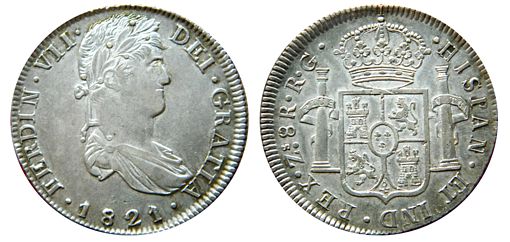
Obverse and reverse of an eight Real 1821 RG Zacatecas coin with a double arc crown di sotto in su
Finally, the abundance of the double arc on the coins of Guadalajara during 1818, 1821 and 1822, leads us to suppose the “di sotto in su” crown was engraved on the chief punch or reproduction die, thus always transferring this variety to the working dies. However, it did not occur so at the Zacatecas mint, where these coins are so rare; we may be sure that the double arc was added manually to the working die or by means of a punch.
Regardless of the reason that caused the appearance of the “di sotto in su” crown, or who gave the order to do it or engrave this peculiarity on the chief punch (at Guadalajara) and on the working die (at Zacatecas) a double effect was achieved: one is the production of 1818, 1821 and 1822 coins with this characteristic at the Guadalajara mint while the other is the fact that a small number of rarities were created at the Zacatecas mint.
